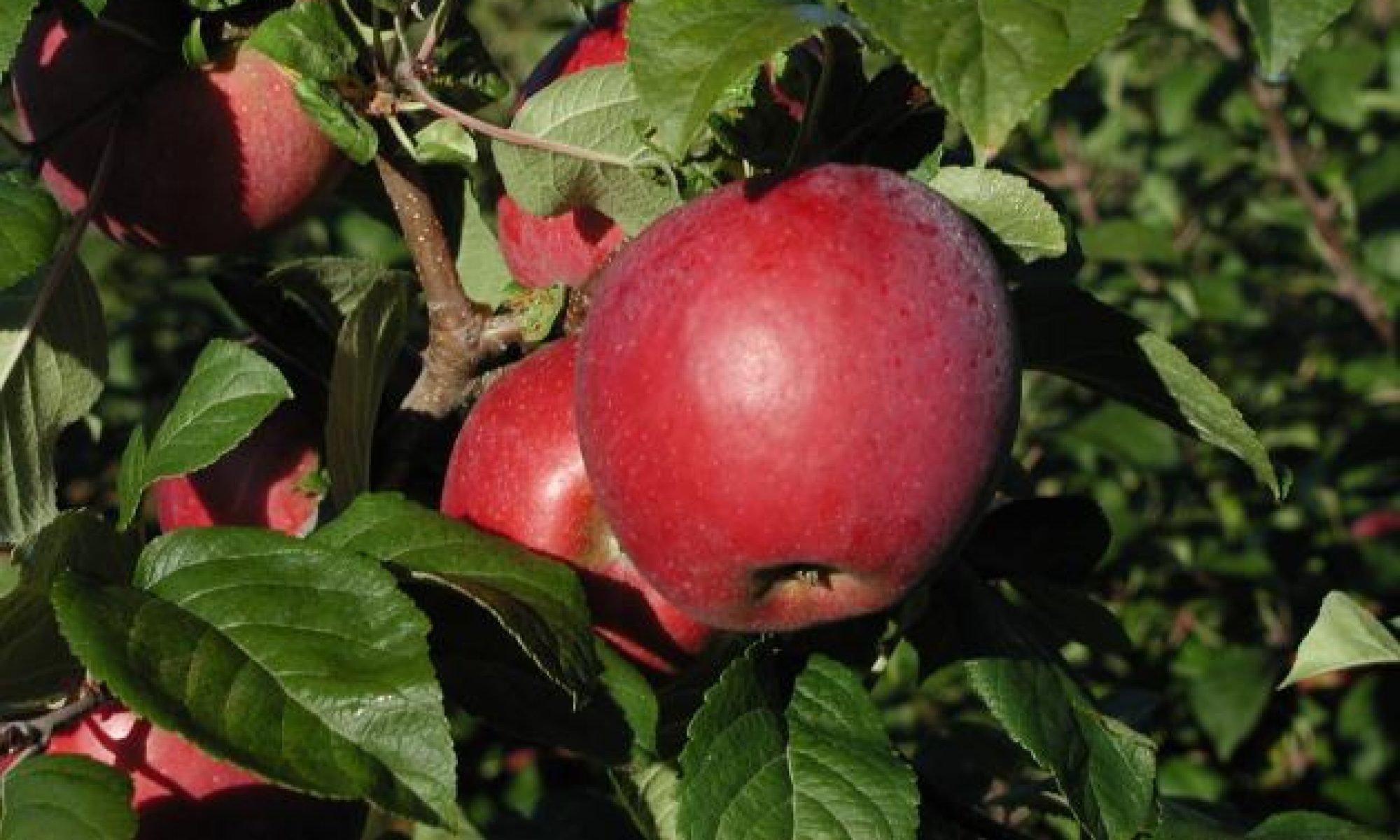| Characteristic | Detail | Description |
|---|---|---|
| Rootstock | P.2 |
Resulted from a cross of M.9 x Common Antonovka and released by the Research Institute of Poland in Skierniewice, Poland. This is a productive, cold hardy, dwarfing rootstock slightly more dwarfing than M.9 NAKBT-337. It is susceptible to fire blight, and wooly apple aphid, but fairly resistant to crown and root rots. It produces few root suckers and burr knots similar to M.9. In NC-140 trials trees survive; depaending on location tree size was similar |
Interstem Apple Trees
Because many dwarfing rootstocks have less than the desired level of cold resistance and trees on all dwarfing rootstocks require support, dwarf rootstocks are sometimes used as interstems to combine the desirable characteristics of a vigorous understock and the dwarfing interstem.
Interstem trees consist of three parts:
- A vigorous rootstock (usually MM.111 or MM.106)
- A dwarfing (usually M.9 or M.27) interstem is grafted to the rootstock. The interstem is usually about 6” long, but additional dwarfing can be obtained by
Apple Rootstock Info: G.11
| Characteristic | Detail | Description |
|---|---|---|
| Rootstock | G.11 |
Resulted from a cross of M.26 and Robusta 5 crabapple and introduced in 1993 by the New York State Agricultural Experiment Station, Geneva, NY. G.11 is one of the more vigorous dwarfing rootstocks and produces a tree similar in size to M.26. It is precocious (similar to M.26), moderately resistant to fire blight, moderately susceptible to woolly apple aphid and crown an root rots, and requires trunk support, especially in the early years. It produces |
Apple Rootstock Info: G.214
| Characteristic | Detail | Description |
|---|---|---|
| Rootstock | G.214 | Geneva 214 (G.214) is a cross of Robusta 5 x Ottawa 3 and tested as CG.4214. Trees on this rootstock will need to be supported and produce a tree about 30-35% size of seedling with vigor and precocity similar to M.9 Nic.29 and M.26. Trees are more productive than those rootstocks and have good cold hardiness, and are resistant to fire blight, Phytophthora root rot and wooly apple aphid. Source: https://extension.psu.edu/apple-rootstocks-capabilities-and-limitations |
| Synonyms | Geneva 214 | |
| Origin |
Apple Rootstock Info: G.210
| Characteristic | Detail | Description |
|---|---|---|
| Rootstock | G.210 |
G.210 is a semidwarfing rootstock that is resistant to fire blight (Erwinia amylovora) and crown rot (Phytopthora spp.). It is a hybrid from a cross between and is larger than Ottawa 3 but smaller than Robusta 5. It is similar in size to Malling 7 but more productive and precocious. |
| Synonyms | Geneva 210 | |
| Origin | Ottawa 3 and Robusta 5 | |
| Availability | Trial | |
| Tree Size | 60-65% | |
| Precocity | Early | |
| Winter Hardiness | Hardy | |
| Suckering | Low | |
| Tree Support Needed | Yes |
Apple Rootstock Info: G.16
| Characteristic | Detail | Description |
|---|---|---|
| Rootstock | G.16 |
Resulted from a cross between Ottawa 3 and Malus floribunda and introduced by the New York State Agricultural Experiment Station, Geneva, NY. G.16 is a dwarfing rootstock and produces a tree similar in size to M.9. It is very precocious and has productivity similar to M.9, and requires full tree support. It is highly resistant to fire blight, quite resistant to crown and root rots, but susceptible to woolly apple aphid. G.16 is hypersensitive to |
Apple Rootstock Info: G.30
| Characteristic | Detail | Description |
|---|---|---|
| Rootstock | G.30 |
Resulted from a cross between M.9 and Robusta 5 and introduced by the New York State Agricultural Experiment Station, Geneva, NY. G.30 produces a fairly vigorous dwarf tree, similar in size to M.26. Precocity and productivity are also similar to M.26. G.30 is highly resistant to fireblight and quite resistant to crown and root rots, but susceptible to woolly apple aphid. G.30 was tested at 20 locations in the NC-140 1994 semi-dwarf rootstock trial with |
Apple Rootstock Info: G.969
| Characteristic | Detail | Description |
|---|---|---|
| Rootstock | G.969 |
G.969 is a semidwarfing rootstock that is resistant to fire blight, crown rot, and woolly apple aphid. It is classified as having growth control between M.7 and MM.106. The rootstocks produce few root suckers or burr knots. Suggested for trial for growers desiring a freestanding tree. |
| Synonyms | Geneva 969 | |
| Origin | N/A | |
| Availability | Limited availability | |
| Tree Size | 70-75% | |
| Precocity | Intermediate | |
| Winter Hardiness | Hardy | |
| Suckering | N/A | |
| Tree Support Needed | No | |
| Where tested within NC-140 or other research |
Apple Rootstock Info: Antonovka 313
| Characteristic | Detail | Description |
|---|---|---|
| Rootstock | Antonovka 313 |
This is a non-dwarfing rootstock from Russia and produces a free-standing tree that is 100% standard size. Trees are slow coming into bearing and moderately productive, and trees may lean slightly in some situations. Although some nurseries advertise Antonovka 313 to be very cold hardy, it is usually considered moderately cold hardy and may be susceptible to late-winter cold. It is adapted to a wide range of soil conditions, and is reportedly resistant to |
Apple Rootstock Info: Alnarp 2
|
Characteristic
|
Detail
|
Description
|
|---|---|---|
|
Alnarp 2
|
Introduced by the Alnarp Fruit Tree Station, in Alnarp, in southern Sweden in 1944. Alnarp 2 was selected in 1920 from a group of mixed Doucin (dwarf) trees and it was brought to the US in 1949. This clonal rootstock propagates easily in the stool bed and produces a free-standing semi-vigorous tree 85 to 90% the size of seedling. Alnarp 2 is very cold tolerant and has been used as an understock for interstem |
